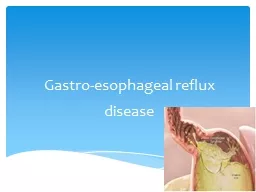

disease GERD is a common condition characterized by prolonged reflux of hydrochloric acid pepsin and bile salts in esophagus oral cavity or respiratory system leading to esophagitis Causes are related to the weakness or ID: 909509
Download Presentation The PPT/PDF document "Gastro-esophageal reflux" is the property of its rightful owner. Permission is granted to download and print the materials on this web site for personal, non-commercial use only, and to display it on your personal computer provided you do not modify the materials and that you retain all copyright notices contained in the materials. By downloading content from our website, you accept the terms of this agreement.
Slide1
Gastro-esophageal reflux
disease
Slide2GERD
, is a common condition
characterized by prolonged reflux of hydrochloric acid, pepsin, and bile salts in esophagus, oral cavity, or respiratory system leading to esophagitis.
Causes are related to the weakness or inappropriate prolonged / frequent transient relaxation of the LES, or delayed gastric emptying.The chief symptom of GERD is frequent and prolonged retrosternal heartburn (dyspepsia) and regurgitation (acid reflux) in relationship to eating or activities.
Key points
Slide3Other symptoms can
include:
chronic cough, dysphagia, belching (eructation), flatulence (gas), atypical chest pain,
and
asthma exacerbationsIf untreated; GERD leads to inflammation, breakdown, and long-term complications.The primary treatment of GERD is diet and lifestyle changes, advancing into medication use (antacids, H2 antagonists, and proton pump inhibitors).
Key points
Slide4Any
factor that relaxes the
LES (smoking
, caffeine, alcohol, or drugs).Any factor that increases the abdominal pressure (obesity, tight clothing at the waist, ascites, or pregnancy.Older age and/or a debilitating condition that weakens the LES tone.Contributing factorsDiet: Excessive ingestion of foods that relax the LES include:
Fatty and fried foods.
Chocolate.Caffeinated beverages such as coffee.Peppermint.Spicy foods.Tomatoes.Citrus fruits.Alcohol.Etilogy
Slide5Slide6Slide7Distended abdomen from overeating or delayed emptying
Increased abdominal pressure (
obesity
, pregnancy, bending at the waist, ascites or tight clothing at the waist)Drugs that relax the LES, such as theophylline, nitrates, calcium channel blockers, anticholinergics, and diazepam (Valium)Drugs, such as NSAIDs, or events (stress) that increase gastric acidDebilitation or age-related conditions resulting in weakened LES toneHiatal hernia (LES displacement into the thorax with delayed
esophageal clearance
)Lying flatEtiology
Slide8Slide9Slide10Slide11Slide12History
: Symptoms 4 to 5 times per week on a consistent
basis
Improvement after a 6-week course of proton pump inhibitors (PPI)Diagnostic interventions taken to differentiate GERD from gastritis and from gastric/peptic ulcer (ulceration of gastric mucosa)Barium meal: pre & post Nsg responsibilities
Endoscopy is used while the client is under conscious sedation to observe
for tissue damage (Nsg responsibilities).Esophageal manometry
is used to measure muscle tone of LES and
pH monitoring
.
Diagnostic Procedures and Nursing Interventions
Slide13Slide14Surgery
(fundoplication) may be indicated for clients who fail to respond.The surgeon wraps the fundus of the stomach around and behind the
esophagus through
laparoscopy to create a physical barrier.New option: Stretta procedure uses radiofrequency energy, applied by laparoscopy, to the LES muscle. This causes the tissue to contract and tighten.Therapeutic Procedures and Nursing Interventions
Slide15Classic
symptoms: Dyspepsia, especially after eating an offending
food/ fluid,
and regurgitation.Other symptoms: Symptoms from throat irritation (chronic cough, laryngitis), hypersalivation, eructation, flatulence, or atypical chest pain from esophageal spasm. Chronic GERD can lead to dysphagia (difficulty swallowing).Assessments
Slide16Assess the client’s:
Dietary intake patterns, paying particular attention to foods
containing caffeine
and fat.Smoking history.Alcohol use.Weight.Assessments
Slide17Acute pain
Deficient knowledge
NANDA Nursing Diagnoses
Slide18Educate
the client regarding:DietAvoid offending foods.
Avoid large meals.
Remain upright after eating.LifestyleAvoid tight-fitting clothing around the middle.Lose weight, if applicable.Elevate the head of the bed 15.2 to 20.3 cm (6 to 8 in) with blocks. The use of pillows is not recommended, as this rounds the back, bringing the stomach contents up closer to the chest.Nursing Interventions
Slide19Slide20Medications
Encourage consistent appropriate use of prescribed medications:
Antacids,
should be administered when the acid secretion is highest (1 to 3 hr after eating and at bedtime). Antacids should be separated from other medications by at least 1 hr.Histamine2 receptor antagonists (ranitidine
(Zantac
), famotidine (Pepcid), nizatidine (Axid), and cimetidine (Tagamet), reduce the secretion of acid. The onset is longer than antacids, but the effect has a longer duration.
Proton pump inhibitors (PPI), omeprazole
(Prilosec
)
reduce gastric acid by inhibiting the cellular
pump necessary
to secrete it. Studies show that PPI are more effective than
H2 antagonists
.
Medications such as metoclopramide hydrochloride (Reglan),
increase the
motility of the esophagus and stomach
.
Prokinetic;
promote gastric emptying
Nursing Interventions
Slide21Pain Management
N&V management
Nutritional needs management
Assess for bleedingNursing Interventions
Slide22Risks
associated with aspiration include:
Asthma exacerbations from inhaled aerosolized acid.
Frequent upper respiratory, sinus, or ear infections.Aspiration pneumonia.Formation of esophageal strictures (scarring).Erosive esophagitis, ulceration, and hemorrhage.Barrett’s epithelium (premalignant) and esophageal adenocarcinoma.Complications and Nursing Implications
Slide23Any questions??????????